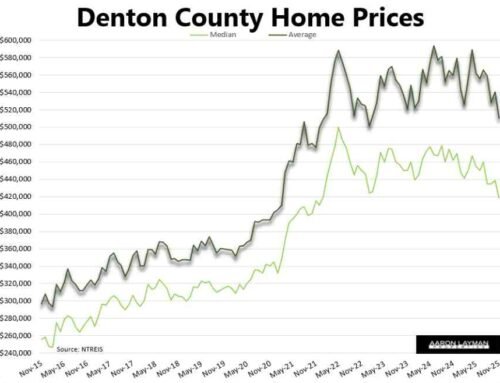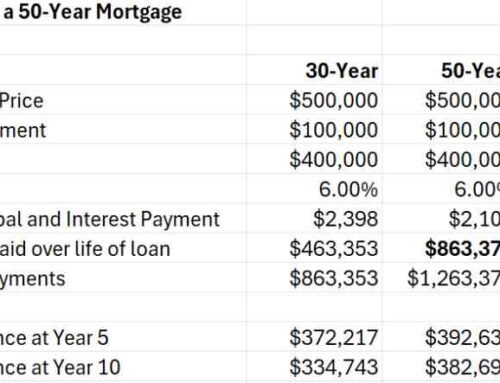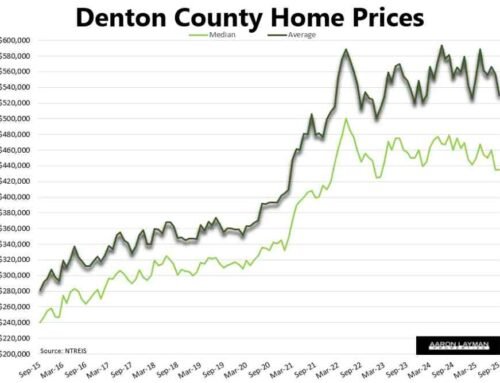More home inventory helped push North Texas home sales into positive territory in April. North Texas saw a 5.5 percent increase in home sales compared to last year while Denton County experienced a 7.3 percent bump in closed transactions. The additional transaction activity was fueled by a 37 percent rise in available home inventory compared to last year.
Inventory has been growing steadily for most of the year as 7 percent interest rates and a slowing economy worked to curtail demand in the housing market. Denton County now has 2.7 months of available home inventory. That’s up 42 percent from the same time a year ago.
Median prices in Denton County edged up just 0.9 percent year-over-year in April. Average prices were one percent lower. That extra supply is providing buyers with more options and keeping prices in check.
Still Normalizing
The housing market continues to normalize after massive Covid-era distortions. Caught between the Federal Reserve’s need for quantitative tightening and the Treasury’s massive deficit-spending stimulus, the housing market is still trying to normalize from unprecedented stimulus which artificially boosted demand and diminished supply.
That normalization process can be seen as more investors unload some of their inventory into the market. The easy money has been made, so some of the overleveraged and inexperienced speculators are selling their homes into a willing market. That’s a good thing. The market still needs more inventory to provide any sustainable path toward affordability.
Over-financialization, hoarding and speculation are still major problems in the U.S. housing market. Don’t expect your local real estate agent to admit this simple fact. Overall sales activity is still depressed. NAR and most of the major brokerages are still reeling from major lawsuits and settlements over inflated commission fees. At this stage of the cycle FIRE industry participants are grasping at any short-term fixes that might generate more sales activity.
Political Hot Potato
Washington is also ramping up the vote-buying shenanigans as we approach the November elections. It’s pretty ironic to see a presidential candidate working to make homes more expensive when U.S. housing affordability is near generational lows.
Biden’s $400 housing tax credit idea is a shameful attempt at buying votes. It’s a ridiculous and dangerous idea which will only serve to stimulate demand and drive prices higher… precisely what the housing market doesn’t need at this stage.
A more sensible policy response would be to free up more inventory by driving out more of the speculators. That requires will and the courage to do the right thing in the face of pushback from asset holders. In an election year it’s much easier to dangle carrots and candy paid for with other people’s money. Whee!
When many American families can’t afford a median priced home, I’m pretty sure we shouldn’t be encouraging existing owners to “trade up for a little more space”.
Tug-of-War Continues
The North Texas housing market is still caught in a tug-of-war in this election year of 2024. On the one hand the market is slowly normalizing as inventory rebounds. On the other you have irresponsible policy responses and massive deficit spending reminiscent of a full-blown financial crisis.
The labor market hasn’t broken…yet. We’re beginning to see some increases in unemployment claims and weaker job numbers in recent weeks. Inflation has exacted a heavy toll on most working families. Discretionary savings are shrinking for many families while many are tapping those revolving lines of credit (aka credit cards).
It’s telling that Fannie and Freddie are tinkering with the ideas to stimulate home equity loans. You know, because that worked out so well in the last housing crisis. Politicians and finance industry participants will likely float more ways to muck up the market to stimulate sales volume. They are generally happiest when the numbers go up. Paying the bill for cleaning up the mess is generally someone else’s problem.
The Futile Effort To Build Our Way Out of the Housing Shortage
The United States still has over 1.6 million housing units under construction based on the April data. This simple fact hasn’t stopped clueless economists and Fed apologists and industry talking heads from talking up a fake housing “shortage”.
The latest housing starts and permits data show single-family completions rose 15.4 percent in April. Completions were 13.6 percent higher than April of last year. This new supply could help offset current housing “shortages”…but it won’t. Rampant financialization and investor activity is more than offsetting increases in new home supply. Builders are even letting their own sales staff remove inventory from the market to cash flow it for their own personal gain.
This is how we end up with the oft-repeated housing “shortage”. This industry-friendly narrative plays well in the financial media and real estate industry circles. It’s complete nonsense, but that’s the current world we live in.
Don’t take my word for it. Just think about all of the spam solicitations you receive every week from investors. There’s no shortage of people or companies ready to buy your home or send you a cash offer. It’s a non-stop barrage of housing financialization fueled by perverse incentives, helicopter money, interest rate manipulation and excess liquidity.
Who’s the Real Customer?
Publicly-traded home builders seem to love their stock more than the homes they sell. The two largest builders spent a combined 2.3 billion in fiscal 2023 on share repurchases. D.R. Horton, America’s largest home builder, repurchased 2.7 million shares of company stock for $402 million in the second quarter of this year. It also paid out $99 million in cash dividends.
D.R. Horton spent $1.2 billion in fiscal 2023 repurchasing company stock. It could have used some of that cash to builder better homes. Horton spent $132 million on warranty & litigation in fiscal 2023, or 11% of the amount spent on enriching investors and executive staff. It almost makes you wonder who the actual customers are in this setup. It looks more like the home buyers are just a means to an end for America’s largest home builders.
If you’ve ever tried to navigate one of the customer service and warranty departments of these builders, you probably understand what I’m talking about. Let’s just say there’s a lot of low-hanging fruit available to improve the overall customer experience.
If you are in the market to buy or sell a home, be safe out there. If you are in the market to sell a home and you don’t want to get stuck paying one of those inflated six percent commissions, give me a call. I would be happy to speak with you.
















Leave A Comment